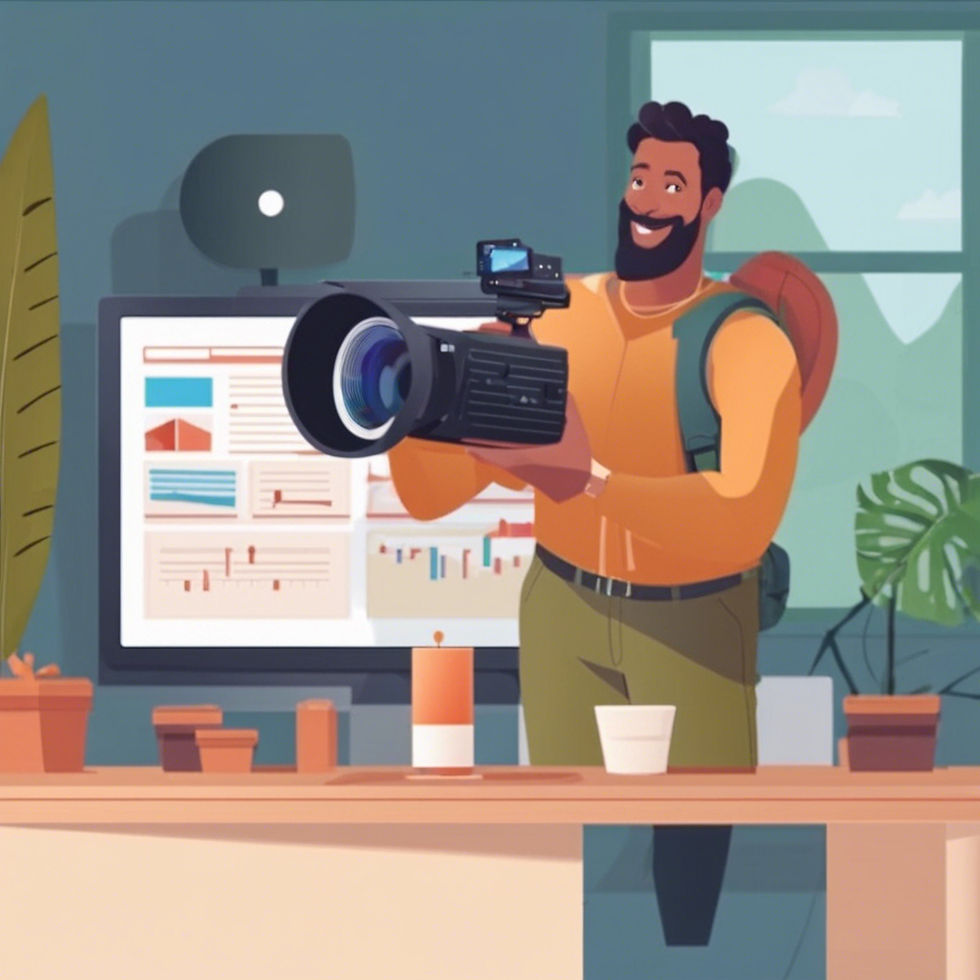Innovative Trends In The Video Production House Industry
- promoraman
- Jun 25, 2024
- 4 min read

The video production industry is undergoing a significant transformation, driven by technological advancements, changing consumer preferences, and new content distribution channels. The following trends highlight the innovative directions shaping the future of video production houses.
1. Virtual Production and Real-Time Rendering
Virtual production is revolutionizing the way videos are made, particularly in the realm of films and high-end TV shows. By integrating real-time rendering technologies, such as Unreal Engine, video production houses can create immersive environments and complex scenes with unprecedented efficiency. This approach blends physical and virtual elements, allowing for more flexibility and creative freedom.
Key benefits include:
Cost Efficiency: Reduces the need for expensive on-location shoots.
Time Savings: Accelerates production timelines by allowing real-time adjustments.
Creative Flexibility: Enables seamless integration of CGI with live-action footage.
2. Remote Collaboration and Cloud-Based Workflows
The COVID-19 pandemic accelerated the adoption of remote collaboration tools. Video production houses are now utilizing cloud-based platforms to manage workflows, share files, and collaborate in real-time across geographical boundaries. This shift not only enhances efficiency but also opens up opportunities to work with talent from around the world without the need for physical presence.
Key components include:
Cloud Storage: For secure and accessible storage of large video files.
Real-Time Collaboration Tools: Such as Frame.io and Wipster, which allow for instant feedback and editing.
Virtual Post-Production Suites: Enabling teams to work on projects simultaneously from different locations.
3. AI and Machine Learning Integration
Artificial Intelligence (AI) and Machine Learning (ML) are being integrated into various aspects of video production, from pre-production planning to post-production editing. AI tools can automate repetitive tasks, analyze vast amounts of data, and enhance creative decision-making.
Applications include:
Automated Editing: AI-driven software can quickly generate rough cuts, saving editors significant time.
Enhanced Visual Effects: Machine learning algorithms can improve the quality of CGI and special effects.
Predictive Analytics: AI can analyze audience preferences and predict trends, guiding content creation.
4. 360-Degree Video and Virtual Reality (VR) Content
Immersive content is gaining traction as Video Production House explore 360-degree video and VR experiences. These formats offer viewers a more engaging and interactive experience, suitable for various applications such as virtual tours, immersive storytelling, and educational content.
Advantages include:
Enhanced Engagement: Immersive content captures viewer attention more effectively.
Innovative Storytelling: Allows for new narrative techniques and audience interaction.
Expanding Markets: Opens up opportunities in gaming, education, and virtual events.
5. High Dynamic Range (HDR) and 4K/8K Resolutions
Advancements in display technology are driving the demand for higher resolution and better-quality video content. HDR and 4K/8K resolutions provide a more lifelike viewing experience with richer colors, greater contrast, and sharper details.
Impact on production:
Increased Production Quality: Requires higher standards in shooting and post-production.
Future-Proofing Content: Ensures content remains relevant as consumer technology advances.
Enhanced Visual Appeal: Meets the growing expectations of audiences for high-quality visuals.
6. Interactive Videos and Shoppable Content
Interactive videos are transforming passive viewers into active participants by allowing them to make choices that influence the storyline. Shoppable content integrates e-commerce with video, enabling viewers to purchase products directly from the video interface.
Benefits include:
Higher Engagement Rates: Interactive elements keep viewers invested in the content.
Direct Monetization: Shoppable videos provide a seamless path from viewing to purchasing.
Data Insights: Interactive features generate valuable data on viewer preferences and behaviors.
7. Social Media Integration and Short-Form Content
The rise of social media platforms like TikTok, Instagram, and YouTube Shorts has popularized short-form content. Video production houses are adapting by creating concise, impactful videos tailored for these platforms.
Trends in this area:
Optimized for Mobile: Short-form content is designed for vertical viewing on smartphones.
Viral Potential: Quick, engaging videos are more likely to be shared and go viral.
Platform-Specific Strategies: Tailoring content to fit the unique style and audience of each platform.
8. Sustainability in Video Production
As environmental concerns become more prominent, video production houses are adopting sustainable practices to reduce their carbon footprint. This includes using energy-efficient equipment, minimizing waste on set, and opting for digital solutions over physical ones.
Sustainable practices include:
Green Production Protocols: Implementing guidelines to reduce environmental impact.
Renewable Energy: Utilizing renewable sources of energy for production activities.
Digital Workflows: Reducing the use of physical materials by moving processes online.
9. Personalization and Custom Content
Personalization is key to engaging modern audiences. Video production houses are leveraging data analytics to create customized content that resonates with individual viewers. This trend is particularly evident in marketing and advertising, where tailored messages can significantly improve campaign effectiveness.
Strategies include:
Dynamic Video Content: Adjusts in real-time based on viewer data.
Targeted Advertising: Uses viewer data to deliver relevant ads.
Content Recommendation Systems: Suggests videos based on user preferences.
10. Blockchain for Copyright and Royalties
Blockchain technology is emerging as a solution for managing copyrights and royalty payments in the video production industry. By providing a transparent and immutable ledger, blockchain can ensure that creators are fairly compensated for their work.
Applications of blockchain:
Smart Contracts: Automate royalty payments based on predefined conditions.
Digital Rights Management: Securely tracks and verifies content ownership.
Transparency: Provides a clear record of transactions and content usage.
Conclusion
The video production house industry is experiencing a period of rapid innovation, driven by technological advancements and changing consumer behaviors. From virtual production and AI integration to immersive content and sustainability efforts, these trends are reshaping the landscape of video production. Embracing these innovations will be crucial for production houses to stay competitive and meet the evolving demands of audiences worldwide.



Comments